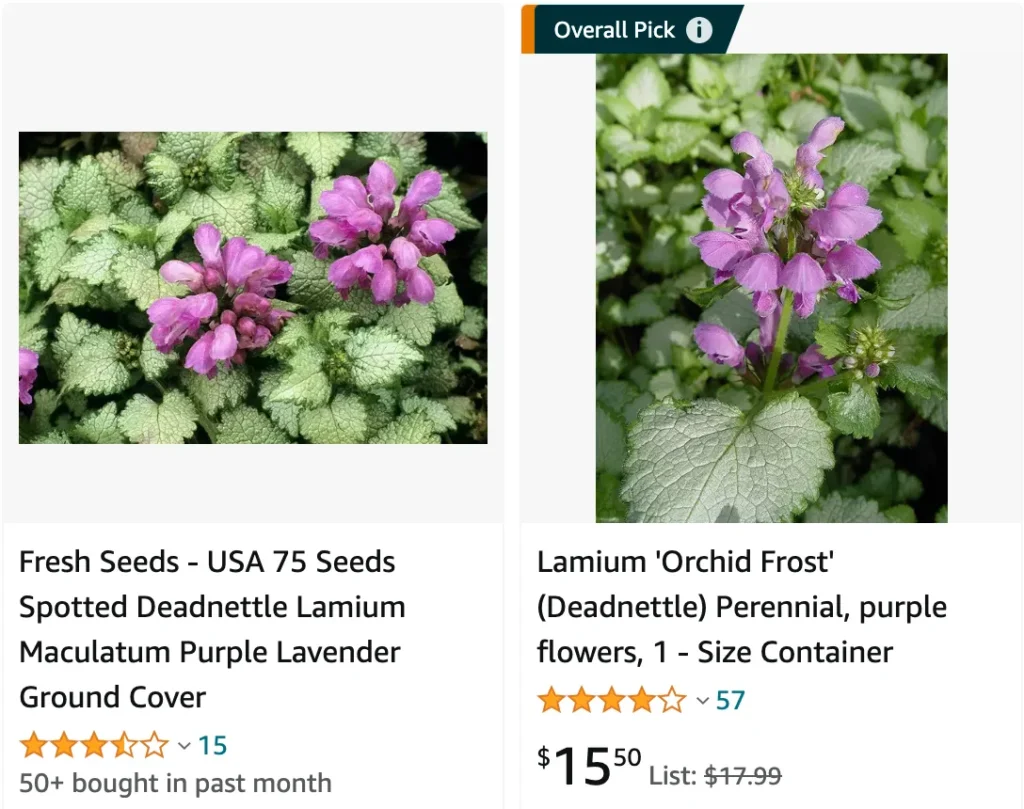
Is Purple Dragon Lamium invasive?
I’ve noticed that Lamium Purple Dragon, or Lamium maculatum, can be quite invasive if not monitored. When I planted it in my garden, it spread quickly, filling in gaps and covering more ground than I initially intended. It’s a beautiful ground cover, but I’ve had to regularly trim it back to prevent it from overtaking other plants in the bed.
34 Species in Genus Lamium
How to care for Lamium Purple Dragon?
Here’s a guide on how to care for your Lamium Maculatum Purple Dragon:
Light:
- Partial to Full Shade: Lamium Purple Dragon thrives in partial shade to full shade. It can tolerate some full sun in cooler climates, but the soil needs to be consistently moist in such conditions.
- Harsh Sun Protection: Avoid harsh afternoon sun, especially in hot climates, as it can scorch the leaves and hinder growth.
Watering:
- Moist but Well-Drained: Water your Lamium Purple Dragon regularly to maintain consistently moist soil but not soggy conditions. They require consistent moisture, especially during hot and dry periods.
- Signs of Thirst: Wilting leaves are a sign that your plant needs water.
Soil:
- Drainage is Key: Well-drained soil is crucial to prevent root rot. Use a good quality potting mix for container plants or amend your garden soil with compost or organic matter to improve drainage.
Fertilizing:
- Moderate Feeder: Lamium Purple Dragon is not a heavy feeder. A single application of a balanced fertilizer in early spring during the active growth phase is sufficient. Avoid over-fertilizing.
Spreading Habit:
- Fast Grower: Be aware that Lamium Purple Dragon is a fast-growing groundcover. You may need to divide or trim it occasionally to control its spread.
Pruning:
- Optional but Beneficial: Pruning is not strictly necessary but can be beneficial for maintaining size and shape.
- You can cut back stems by about half their height after flowering (typically around late spring or early summer) to encourage bushier growth.
- Remove dead, diseased, or damaged foliage throughout the growing season.
Winter Care:
- Mild Climates: In mild climates (USDA zones 7-9), Lamium Purple Dragon is generally evergreen.
- Colder Climates: In colder climates (USDA zones 4-6), the foliage may die back in winter but will typically return in spring. You can apply a layer of mulch (2-3 inches thick) around the base of the plant in fall to protect the roots from freezing temperatures.
Pests and Diseases:
- Generally Resistant: Lamium Purple Dragon is generally resistant to pests and diseases. However, watch for common garden problems like slugs, snails, or powdery mildew.
- Natural Solutions: You can use organic methods like beer traps (for slugs/snails) or neem oil (for powdery mildew) if necessary.
Additional Tips:
- Lamium Purple Dragon is a low-maintenance groundcover that adds beautiful color and texture to your garden.
- Its attractive purple foliage and lavender flowers provide visual interest throughout the season.
- It can be a good choice for borders, walkways, or underplanting trees and shrubs in shady areas.
Is Lamium maculatum Purple Dragon an annual or perennial?
In my experience, Lamium maculatum Purple Dragon is a perennial. Every spring, I see it come back, filling my garden with its vibrant purple blooms and variegated leaves. It’s great not having to replant it each year, as it adds consistent color and texture to my garden season after season.
Is Purple Dragon Lamium deer resistant?
From what I’ve seen, Purple Dragon Lamium is quite deer resistant. I’ve got deer wandering through my yard occasionally, but they’ve never touched this plant. It’s been a relief to find a plant that adds beauty to my garden without becoming a buffet for the local wildlife.
Where can I buy Purple Dragon Lamium online?
When I wanted to buy Purple Dragon Lamium online, I found several options. I’ve had good luck ordering from plant-specific retailers like Proven Winners and Bluestone Perennials, as they offer a variety of healthy plants. I also checked larger online marketplaces like Amazon and eBay, where I’ve found competitive prices and a broader selection.
If i die, water my plants!



